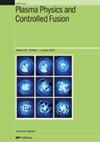负三角形试验设备的垂直稳定性评估
IF 2.3
2区 物理与天体物理
Q2 PHYSICS, FLUIDS & PLASMAS
引用次数: 0
摘要
负三角形(NT)托卡马克构型可能更容易受到磁流体动力不稳定性的影响,这给近期以其有利特性为中心的反应堆设计带来了挑战,例如改进的约束性和无边缘定位模式的运行。在这项工作中,我们评估了等离子体在 NT 塑造下的垂直稳定性,并开发了潜在的反应堆解决方案。经证实,当与共形壁耦合时,NT 平衡的垂直稳定性低于等效的正三角形(PT)配置。与正三角形构型不同的是,其垂直稳定性在较高极性贝塔时会降低。此外,低纵横比时垂直稳定性的提高并没有转化为 NT 几何结构。在 PT 真空容器中,由于等离子体和外侧壁的距离增加,NT 平衡得到了稳定,但由于垂直间隙减小,控制恢复的空间余量减少,这种情况并不理想。相反,我们证明了被动导电板的明智定位可以提高 NT 配置的垂直稳定性,与 PT 方案中预期的稳定性指标相当。我们提出了高伸长 NT 设备中被动板的最佳设置,其中位于设备外侧的板可将垂直不稳定性增长率降至基线值的 16%。对于较低的目标伸长率,将被动稳定器与分流器概念相结合可显著提高垂直稳定性。装置内侧的板在 NT 几何结构中也是独一无二的,为垂直稳定线圈和被动稳定器的空间分离提供了机会。本文章由计算机程序翻译,如有差异,请以英文原文为准。
Assessment of vertical stability for negative triangularity pilot plants
Negative triangularity (NT) tokamak configurations may be more susceptible to magneto-hydrodynamic instability, posing challenges for recent reactor designs centered around their favorable properties, such as improved confinement and operation free of edge-localized modes. In this work, we assess the vertical stability of plasmas with NT shaping and develop potential reactor solutions. When coupled with a conformal wall, NT equilibria are confirmed to be less vertically stable than equivalent positive triangularity (PT) configurations. Unlike PT, their vertical stability is degraded at higher poloidal beta. Furthermore, improvements in vertical stability at low aspect ratio do not translate to the NT geometry. NT equilibria are stabilized in PT vacuum vessels due to the increased proximity of the plasma and the wall on the outboard side, but this scenario is found to be undesirable due to reduced vertical gaps which give less spatial margin for control recovery. Instead, we demonstrate that informed positioning of passively conducting plates can lead to improved vertical stability in NT configurations on par with stability metrics expected in PT scenarios. An optimal setup for passive plates in highly elongated NT devices is presented, where plates on the outboard side of the device reduce vertical instability growth rates to 16% of their baseline value. For lower target elongations, integration of passive stabilizers with divertor concepts can lead to significant improvements in vertical stability. Plates on the inboard side of the device are also uniquely enabled in NT geometries, providing opportunity for spatial separation of vertical stability coils and passive stabilizers.
求助全文
通过发布文献求助,成功后即可免费获取论文全文。
去求助
来源期刊

Plasma Physics and Controlled Fusion
物理-物理:核物理
CiteScore
4.50
自引率
13.60%
发文量
224
审稿时长
4.5 months
期刊介绍:
Plasma Physics and Controlled Fusion covers all aspects of the physics of hot, highly ionised plasmas. This includes results of current experimental and theoretical research on all aspects of the physics of high-temperature plasmas and of controlled nuclear fusion, including the basic phenomena in highly-ionised gases in the laboratory, in the ionosphere and in space, in magnetic-confinement and inertial-confinement fusion as well as related diagnostic methods.
Papers with a technological emphasis, for example in such topics as plasma control, fusion technology and diagnostics, are welcomed when the plasma physics is an integral part of the paper or when the technology is unique to plasma applications or new to the field of plasma physics. Papers on dusty plasma physics are welcome when there is a clear relevance to fusion.
 求助内容:
求助内容: 应助结果提醒方式:
应助结果提醒方式:


